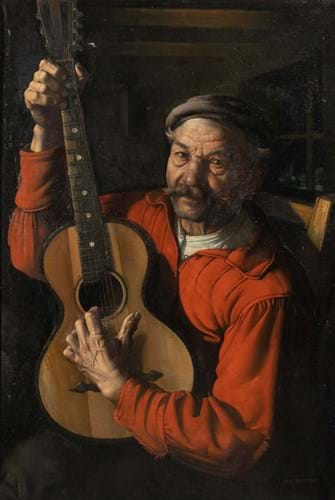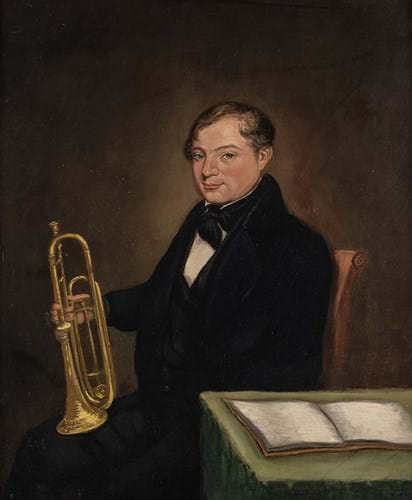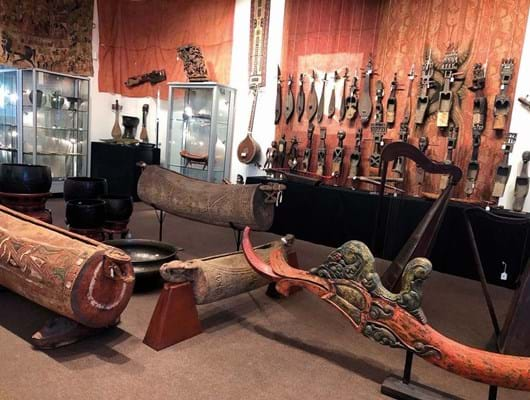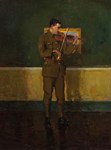There’s not much that Tony Bingham doesn’t know about old musical instruments.
The LAPADA dealer began dealing in historic instruments in the mid-1960s and has published nine books on the subject.
He first set up a shop on the King’s Road in the 1960s, followed by premises on Soho’s Poland Street before then moving to a gallery on Pond Street, Hampstead, which was his base for almost four decades.
After closing the shop and retiring, the business continues to be run by his wife Irene from their home nearby in Willoughby Road.
This final move precipitated the consignment of 40 paintings all with a musical theme to Olympia Auctions (25% buyer’s premium) in west London.
These portraits of musicians spanning the 17th-20th centuries had been hung in the various premises he occupied; the images of string, wind and brass players and singers providing the perfect backdrop for a shop selling pieces of musical history.
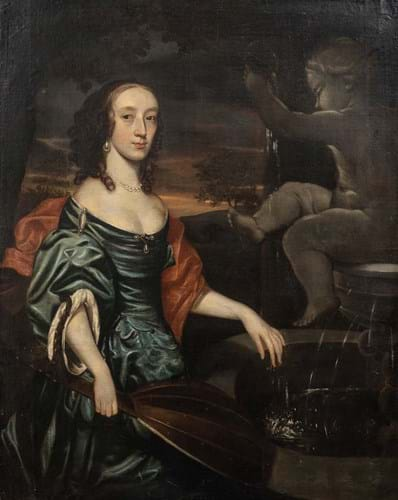
Portrait of a young woman holding a theorbo, catalogued as ‘circle of Sir Peter Lely (1618-80)’ – £4400 at Olympia Auctions.
Variations on a theme
Most of the pictures had been chosen for their musical subject matter rather than their artistic prowess, which meant some pictures were copies ‘after’ well-known Dutch or British portraits, while others were the work of unknown artists.
The collection had been assembled through purchases from dealers and auctions as well as other collectors, with many of the works acquired during Bingham’s extensive travels over the decades.
They appeared at Olympia’s British and Continental art sale on April 21 which, pitched at attractive estimates, was a white-glove affair. The 40 lots all sold, raising a £74,085 hammer total against a combined low-estimate of £27,930.
The auction house reported interest and bidding from musicians, musical instrument dealers, instrument makers and museums as well as collectors and art dealers from different countries.
Among the most notable performances were those where the sitter was a famous musician or the instruments featured had some historical interest.
Guitar hero
For the top lot of the sale it was a combination of rare artist and subject that propelled demand.
Portrait of a man playing a guitar by Jan Zamoyski (1901-86) made the highest price of the day by some distance.
The Polish painter, stage designer and decorator – whose works ranged from historical subjects to socialist realist scenes – exhibited quite widely abroad before the Second World War including at the Musée Rath in Geneva (1931) and the Brooklyn Museum in New York (1933).
While his pre-war work is particularly rare today, it helped him become a highly regarded artist in Poland – he painted a fresco depicting scenes from Polish history that adorned the lobby of the Military Geographical Institute in Warsaw, for example.
Zamoyski’s career was interrupted by wider events as he was drafted as the war broke out in 1939 before then being captured and spending the remainder of the conflict in a Nazi prisoner-of-war camp.
After liberation he became a decorated soldier – receiving the Cross of Military virtue, the equivalent to the Victoria Cross – but also continuing to enhance his reputation as a painter and designer in his homeland.
Today, many of his works reside in Polish museums and not many have ever appeared at auction. Of the handful of recorded results on Artprice, the highest was a large figurative painting titled Expatriates 1915 that made PLZ320,000 (£63,260) at an auction in Warsaw.
The 3ft 4in x 2ft 2in signed oil on canvas here was therefore a rare commercial opportunity and it was also the first picture by Zamoyski to emerge with a musical subject.
In addition it drew admirers for its intriguing composition and light sourcing, and the estimate of £3000-4000 was deemed attractive to a number of parties. It was quickly taken well beyond predictions and bid to £36,000, at which point it was knocked down to an overseas collector. The sum appears to be the highest for the artist outside Poland.
Famous sitters
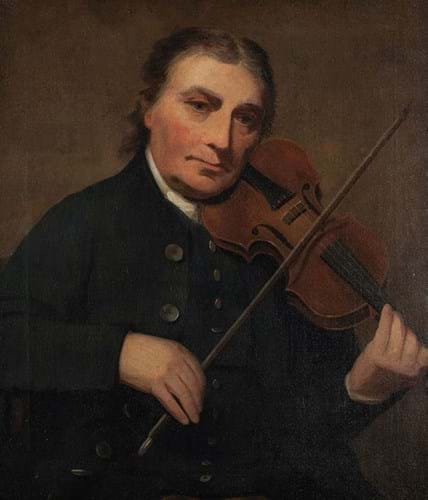
A portrait of the fiddler Neil Gow catalogued as ‘after Sir Henry Raeburn’ – £4000 at Olympia Auctions.
Elsewhere at the sale, a number of portraits depicting famous musical sitters drew attention including a painting of the fiddler Neil Gow.
The 2ft 4in x 2ft in (72 x 61cm) oil on canvas was catalogued as ‘after Sir Henry Raeburn’ – the larger original hangs in the Scottish National Portrait Gallery and shows the musician wearing tartan trousers. This was a smaller half-length copy but it clearly had admirers, especially against an estimate of £400-600.
The best-known Scottish fiddler of the 18th century, Gow, the son of a plaid weaver from Inver in Perthshire, was a largely self-taught but virtuoso musician who enjoyed the patronage of the Scottish aristocracy (particularly the Duke of Atholl and the Duchess of Gordon).
The poet Robert Burns visited Gow in 1787 (the year he was painted by Raeburn) and described him as “a short, stout-built, honest highland figure, with his greyish hair shed on his honest social brow – an interesting face, marking strong sense, kind open heartedness mixed with unmistrusting simplicity”.
With the subject matter the primary driver of demand here, it sold at £4000 to a UK collector.
Court copy
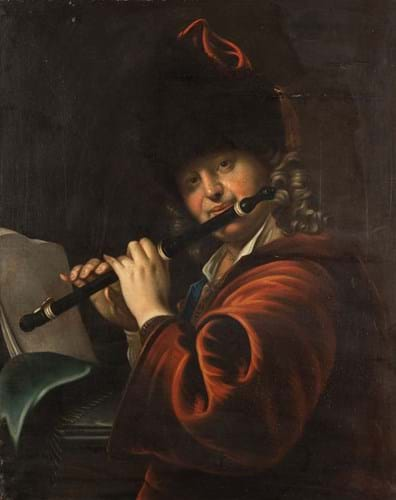
Portrait of the musician Josef Lemberger, catalogued as ‘after’ Ján Kupecký – £1200 at Olympia Auctions.
It was a similar case for a portrait of the court musician Josef Lemberger (1667-1740) painted ‘after’ an original by the Czech portraitist Ján Kupecký (1666-1740).
That original is now part of the collection at Germanisches National Museum in Nuremberg but this 3ft 3in x 2ft 6in (98 x 76cm) copy was bid to £1200 against a £400-600 estimate. It sold to a UK dealer.
Also selling to the trade was a portrait of a young woman catalogued as ‘circle of Sir Peter Lely (1618-80)’ which surpassed a £400- 600 estimate and took £4400.
Interestingly the sitter in the 4ft 1in x 3ft 3in (1.24m x 98cm) oil on canvas, who is shown next to a marble statue, holds a theorbo – an instrument similar to a lute but with a much longer neck which extends beyond the regular fingerboard.
The instrument was first introduced in Italy at the end of the 16th century and was used by 17th-century French lutenists, but its presence in England at this time was not widespread. This element of the subject may well have been among the reasons it easily overshot predictions.
An unusual instrument also helped garner interest in a separate picture. The English school portrait of a trumpeter from c.1850 showed the sitter holding a rare model of a slide trumpet.
While slide trumpets have been around since the late 14th century (they may have been derived from the war trumpet), the slide did not significantly change the pitch with a smaller instrument and so, in contrast to the trombone which became more favoured, it was not common to see trumpets with a slide-return mechanism by the Victorian era.
The 23½ x 19in (60 x 48cm) oil on canvas here was again pitched at £400-600 and it sold at £1600 to a European collector.
Quartet quids in
Rather different to the portraits on offer but also attracting interest was a small oil by Gertrude Homan (fl.1886-1905), a little-known artist who seemingly favoured musical subjects and who exhibited designs for the music room panels at the Royal Academy in 1893 according to the catalogue.
The 14in x 2ft 5in (49 x 85cm) oil on canvas was titled A string quartet and drew significant interest against a £300-500 estimate, selling at £1800 to a UK dealer.
With almost every lot bringing bidding beyond estimate, the performance of the Bingham collection must have been music to the saleroom’s ears.
Expanded offering
Olympia Auctions is now holding sales in its revamped base. The saleroom said: “Being located in central London, we are fortunate in our proximity to the core London trade, international visitors, and our loyal private clients. Space here at 25 Blythe Road has been at a premium but now our ambition to improve this has been realised with the completion of phase one of our renovations.
“The gallery at Olympia Auctions has expanded to over 100 sq m (approx 1100 sq ft) with increased height to 4.6m (15ft) and has already served us very well for our two recent sales.
“Additionally, we have a new space upstairs for storage, cataloguing and photography and have plans for further private meeting spaces for clients. We are also pleased to announce that our newly acquired warehouse in west London is near completion and will be operational in the coming months.”


